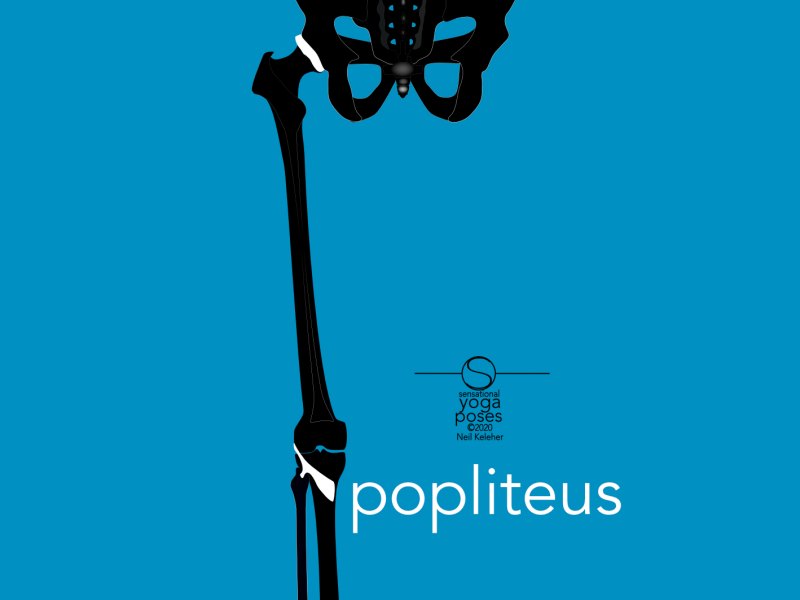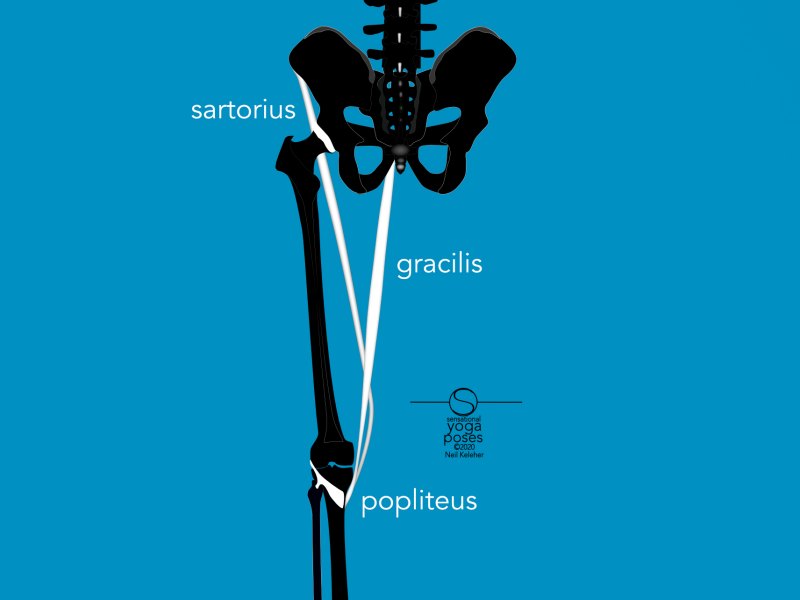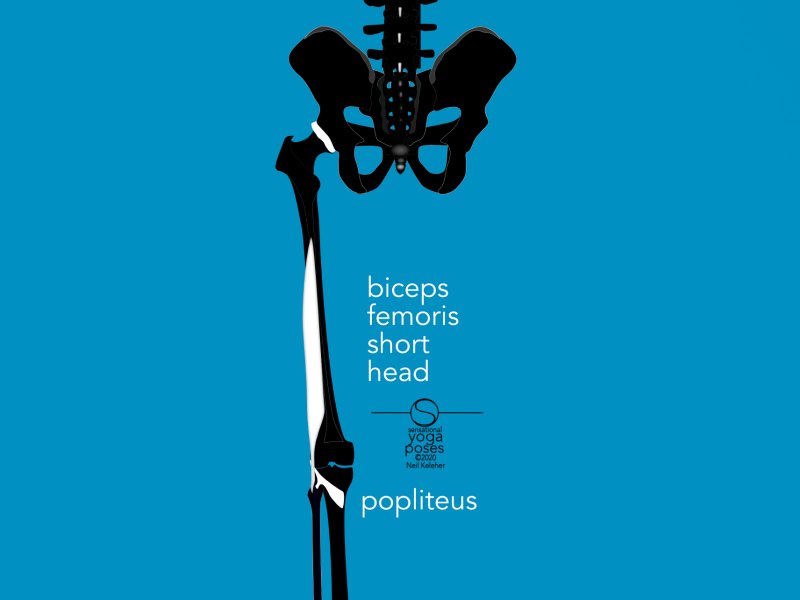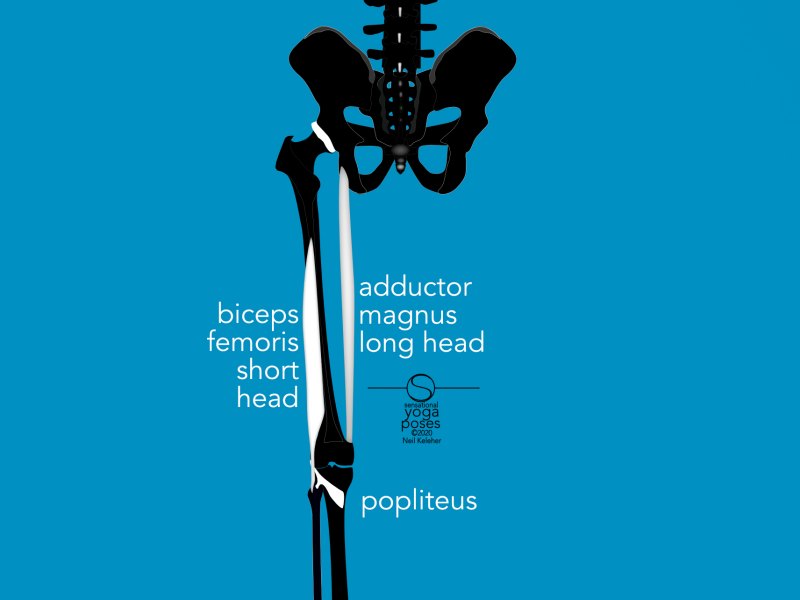The popliteus
A small but important muscle that can stabilize the knee against rotation
One of the smallest (and seemingly most innocuous) muscles that acts directly on the knee joint, and only on the knee joint, is the popliteus muscle.
It's an internal knee rotator meaning that it resists external rotation of the tibia relative to the femur, or helps to drive internal rotation of the tibia relative to the femur.
Sartorius is also an internal knee rotator
Note that another important muscle in rotating the shin internally relative to the femur is the sartorius (and the gracilis may also help to rotate the tibia internally in some situations.)
Note that both the sartorius and the gracilis are multijoint muscles. The both act on both the knee joint and the hip joint. They both could be thought of as "long thigh muscles". (Personally, I used to label them as "long hip muscles", but that name doesn't take into account that both muscles work on the knee as well as the hip). And both attach to prominent corner points of the pelvis.
The relatively short popliteus
In contrast, the popliteus is relatively short. It attaches to the outside of the bottom of the femur, at the knee joint. It crosses the back of the knee joint moving downwards and inwards, to attach near the top of the inner edge of the tibia, fairly close to where the sartorius and gracilis (and semitendinosus) all attach to the tibia.
The popliteus has an attachment to the fibula
The popliteus does have an attachment to the fibula, and what this could mean is that if the fibula exeriences a forward pull (causing internal rotation of the lower leg relative to the femur), it can transmit that pull to the popliteus. Basically, it could be a means of telling the popliteus to activate so that the tibia is rotated internally along with the fibula.
The biceps femoris short head
Another single joint muscle that acts on the knee is the biceps femoris. This muscle attaches to a large portion of the back of the femur. From there it crosses the back of the knee, towards the outside, to attach to the top of the fibula.
Note that the tendonous offshoot from the popliteus attaches quite close to where the biceps femoris attaches.
The popliteus and biceps femoris short head, working together to control knee rotation
Where the popliteus can work to internally rotate the tibia relative to the femur, the biceps femoris short head does the opposite and creates an external rotation force on the fibula.
Thus the two muscles could work together to help stabilize the knee against rotation.
This could be fairly important when the knee is straight or nearly straight and bearing weight say while standing, and in particular when trying to balance on one leg, or when about to deal with impact forces while walking, jogging or running.
Consequences when a knee lacks rotational stability, a collapsed arch
One possible consequence of a lack of knee rotation stability in any of the above situations is a foot (or heel) that tends to collapse inwards. So for example, while trying to balance on one foot, or even while standing on both feet for long periods of time, the inner arch of the foot may collapse.
While walking or running, the same can happen as the foot impacts or lands on the floor (though this may depend on the style of walking, jogging or running, i.e. whether heel striking, mid-foot striking or forefoot striking).
Why does a lack of knee rotation stability cause a collapsed arch?
The muscles of the lower leg and foot that help to support the inner arch of the foot attach from the lower leg bones to the bones of the foot. This can include muscles like the peroneus longus and brevis, the tibialis posterior and tibialis anterior as well as the muscles that attach from both lower leg bones to work attach to the top and bottom of the toes.
Working from a stabilized foot, these muscles can cause the shin bones to rotate relative to the foot. And so for these muscles to be able to effectively shape the foot (and lift the inner arches), it helps if the shin is rotationally stable. And for that it helps if the popliteus can function properly.
Anchoring the muscles that shape the foot
Note that you might think that to help lift the arch of the foot all you need is for the biceps femoris short head to activate (or failing that, the long head). In order to function effectively, any muscle needs an opposing force to work against.
In the case of stabilizing the knee joint, the biceps femoris short head needs an opposing force to work against, and that can be provided by the popliteus. Note that because the biceps femoris short head is a large muscle, it can probably produce more force than the popliteus, and this excess force then goes towards working against the forces created by the lower leg muscles as they maintain foot posture.
Giving knee rotation stabilization a boost
When the knee is dealing with greater forces, say while walking or running, the muscles that stabilize the knee against rotation may need a boost. And this can come from muscles like the sartorius and the adductor magnus long head.
Note that even though the adductor magnus long head doesn't cross the knee, it's attachment to the femur is quite close to the knee joint.
Since the sartorius also works on the hip joint, this can require coordination between muscles that work on the knee or the hip (or that work on both the knee and the hip).
Stabilizing the femur
Even when the sartorius isn't required for extra knee rotation stability, so that the popliteus to work effectively, it too needs a stable end point or anchor. And that can come from also stabilizing the femur against rotation at the hip joint.
And the adductor magnus long head may be an important muscle in this regard.
Stabilizing the lower leg bones
An alternative for anchoring one end of the popliteus is to stabilize the lower leg bones instead. In particular, work at stabilizing the lower leg bones against rotation relative to the foot. This generally requires stiffening of the foot and ankle.
Activating the popliteus muscle
Assuming that there is no tissue damage (or that any tissue damage has healed), a simple method for activating the popliteus is to draw the top of the inside of the tibia rearwards relative to the outside of the bottom of the femur. While doing this, keep the bottom of the femur still. For a stronger sensation, you could work at keeping both the femur and the tibia still while trying to create a rearward pull on the inner edge of the top of the tibia.
Published: 2020 08 08
Updated: 2021 02 11






